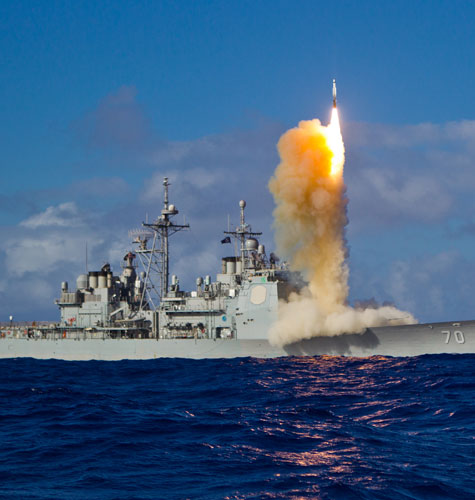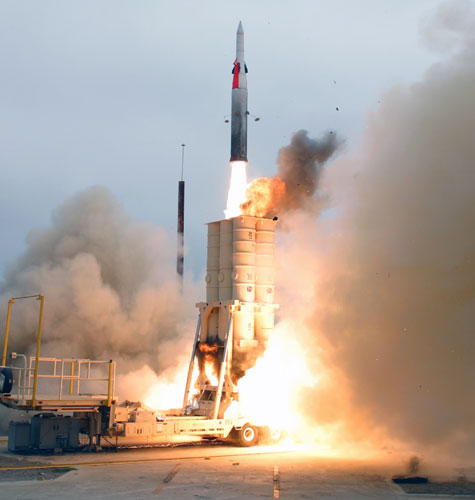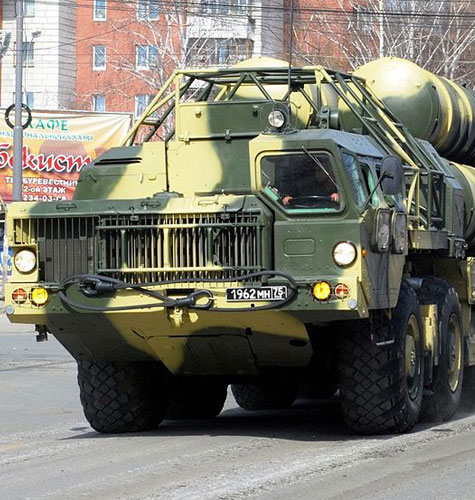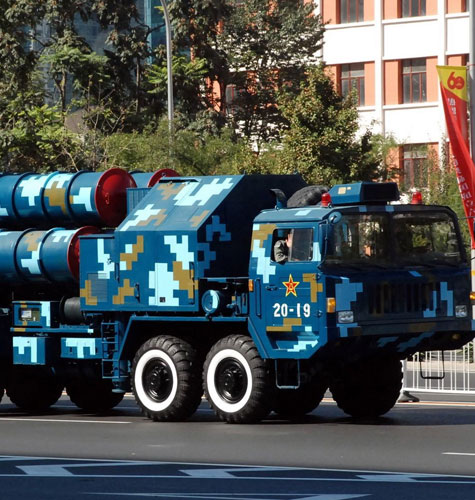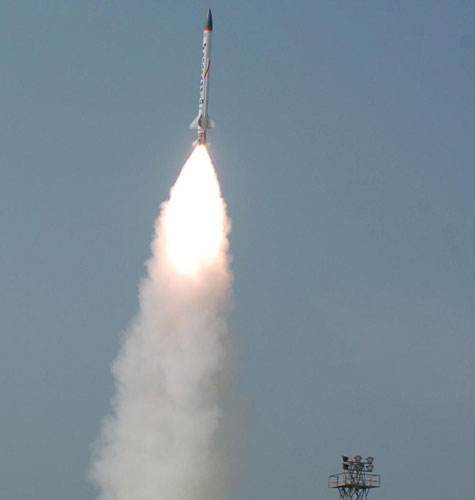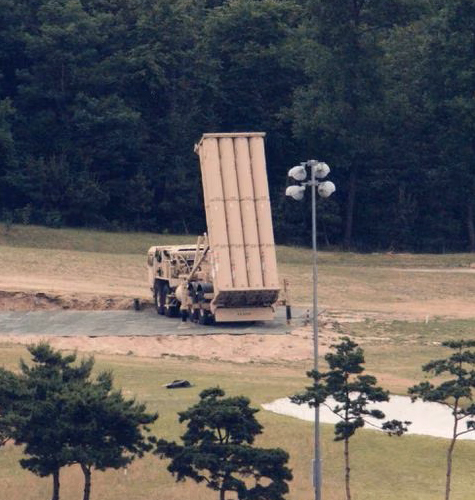Updated: 2023
What is missile defense?
- Missile defense is meant to stop an offensive missile attack. It involves a set of measures to detect, identify, track, and defeat attacking ballistic missiles while in flight. Each of these measures must work in concert to accomplish the mission.
- Missile defense systems in use today are designed to destroy an incoming missile with another missile, either by colliding with the offensive missile or exploding at or near it.
- Future missile defense systems may use high powered lasers deployed on the ground or in space.
- Missile defense is a hotly debated issue.
- Proponents argue it is necessary to address the proliferation of ballistic missiles to additional countries, some of which are suspected of pursuing nuclear weapons and may not be deterred from using them by the threat of a retaliatory strike.
- Opponents argue missile defense is expensive, easily defeated with straightforward countermeasures, and could lead some countries to build up their offensive nuclear arsenals.
How is missile defense supposed to work?
- Missile defense remains a largely unproven capability. Missile defense systems have been used against shorter-range rockets in several conflicts with varied success but have never intercepted and destroyed a long-range missile in a real-world scenario.
- Defeating an incoming missile along its trajectory is an enormous feat, not so dissimilar from hitting a bullet in flight with another bullet.
- The earliest missile defense interceptor concepts relied on nuclear explosives to destroy incoming missiles. Most missile defense systems today rely on so-called “hit-to-kill” technologies, in which the kinetic energy of an interceptor destroys a missile by slamming into it.
- A country may use different technologies depending on whether it attempts to intercept a missile when it is traveling up (boost phase), coasting through space (midcourse phase), or falling back to earth (terminal phase).
- In sophisticated missile defense systems, system components may be separated by thousands of miles, while in other systems, some of these components can be collocated.
Boost Phase |
Midcourse Phase |
Terminal Phase |
|---|---|---|
| The boost phase offers a small, but potentially attractive window of opportunity to attack a missile. | The midcourse phase offers the largest window (about 20 minutes for an ICBM) to intercept an incoming missile. | The terminal phase offers the smallest window to attack an incoming missile and is both difficult and risky. |
| Missiles are most vulnerable during this phase because they are traveling at slower speeds and the heat plume for their engines makes them easier to track. | However, midcourse intercepts are extremely difficult because defenses must typically track and target re-entry vehicles which are smaller, emit little heat, and can travel in excess of 7 km per second. | After entering the atmosphere, a reentry vehicle from an ICBM may take only less than a minute to reach its target leaving little time to launch an interceptor. |
| "Hit-to-kill" technologies, lasers, and other directed energy weapons may, in theory, be able to defeat boosting missiles, but today are likely unworkable in practice. | Countries such as the United States and its NATO allies rely on "hit-to-kill" technologies for midcourse defense, but questions remain about their reliability against long-range missiles. | Upon re-entry it becomes easier to distinguish decoys from genuine warheads since they will travel at different speeds. However, to protect large targets and have adequate coverage many interceptors are needed close to the target. |
| Missile defense assets need to be placed within range of a missile launch site and initial flight path, which is often unrealistic because adversaries can launch missiles by surprise and from deep inside their territories or from ships or submarines at sea. | For example, tests of the U.S. Ground-based Midcourse Defense (GMD) system have recorded 9 hits with a kill vehicle out of 17 tries since 1999, and the system has never been tested against a target with the range and speed of an ICBM. | Terminal phase defenses, are a last resort option. The United States has developed several "hit-to-kill" systems for this purpose, but these are designed to defend against slower short-to-medium-range missiles and have limited capability against ICBM’s |
Which countries deploy missile defenses?
Is a missile defense system different from an anti-satellite system?
- There are no major differences between attacking a target in space that is in orbit (i.e. a satellite) and attacking a target passing through space (i.e. a missile). Because satellites are traveling on a fixed orbital path, they are more vulnerable to interception than ballistic missiles in flight.
- The United States and other countries have used the same technologies for intercepting both missiles and satellites. In a 2008 test, the United States made relatively minor software changes to allow an Aegis missile defense ship to intercept a non-functioning U.S. spy satellite. China, too, has used its hit-to-kill system to intercept both a satellite and ballistic missiles.
- Because direct ascent anti-satellite (ASAT) missile tests create significant quantities of debris in space, they are controversial and can negatively impact other uses of space.
- Countries like China and Russia have also developed non-kinetic anti-satellite weapons such as lasers and electronic warfare systems that can carry out non-physical attacks that are designed to disrupt or damage satellites.
How can countries defeat missile defenses?
The increasing sophistication of missile defenses has led some countries to develop countermeasures to overcome them. Such countermeasures are referred to as penetration aids, or PENAIDS for short. Russia and China, according to the U.S. intelligence community, “each have developed numerous countermeasures.” [1]
- Simple PENAIDS that a country like North Korea might develop include “balloon” decoys or electronic measures such as “jammers” or microwaves to interfere with missile defense sensors and onboard electronics. Constructing decoys may not pose a serious engineering challenge for countries that already know how to produce ballistic missiles and reentry bodies.
- Decoys pose a technical problem for missile defense systems at the midcourse phase. Since there is no air resistance in space, the lighter decoys would travel at essentially the same speed as the heavier warhead. The decoys could also be heated to prevent sensors from picking out the warhead among the cloud of decoys. Adding further complications, the warhead itself could be wrapped in a protective radar-reflecting balloon to disguise it as a decoy.
- Decoys are burned away upon re-entry into the atmosphere as the missile enters the terminal phase, but it may only take the warhead an additional 30 seconds to reach its target in the terminal phase, making an intercept difficult and risky.
Do missile defense systems pose proliferation concerns?
- Some states may respond to the deployment of missile defenses by building more offensive missiles, developing countermeasures or building anti-satellite weapons that can target sensors or other missile defense components in orbit.
- Some states may repurpose missile defense interceptors to serve as ballistic missiles. Iraq, South Korea and Taiwan all used surface-to-air missiles to develop surface-to-surface missiles. Chinese and Russian observers have expressed concerns that land-based versions of the U.S. SM-3 missile—used for missile defense—could be redesigned to provide an intermediate-range ballistic missile.
- The spread of missile defense technologies could also result in the spread of anti-satellite capabilities, which is a worrisome development for the commercial space industry as well as intelligence communities around the world. India, for example, is developing a hit-to-kill system for missile defense but has recently expressed interest in developing anti-satellite weapons as well. Although there is no prohibition on developing anti-satellite weapons, various nations have proposed codes of conduct or treaties to limit or ban anti-satellite weapons.
- Although there is no prohibition on developing anti-satellite weapons, various nations have proposed codes of conduct or treaties to limit or ban anti-satellite weapons. Intending to establish a new norm against anti-satellite missiles, the United States committed to not testing such systems in April 2022. [2]
[1] National Intelligence Council, Foreign Missile Developments and the Ballistic Missile Threat to the United States through 2015, September 1999.
Note: Header Image Credit: US Navy, June 22, 2006, www.navy.mil
[2] Kimball, Daryl, “US Commits to ASAT Ban,” Arms Control Association, May 2022, https://www.armscontrol.org/act/2022-05/news/us-commits-asat-ban.
Photo Credits for “Intercepting a Ballistic Missile” Graphic:
[1] Launch Detection: A United States Air Force Support Defense Support Satellite. Source: www.gulflink.osd.mil
[2] Missile Tracking: Pictured here is the United States AN/TPY-2 also known as FBX-T. Source: www.mda.mil
[3] Interceptor: Pictured here is the SM-3 interceptor missile launched in 2014 from the US USS JOHN PAUL JONES (DDG-53) during a test over the Pacific Ocean. Source: www.mda.mil
[4] Enemy missile launched enroute to its target. Pictured here is the launch of the LGM-30G Minuteman III ICBM. Source: www.minot.af.mil
[5] Warheads and Decoys: Pictured here are United States Air Force maintenance personnel in training to remove and install the MK-21 re-entry vehicles from a Peacekeeper missile. Source: www.nationalmuseum.af.mil
[6] Kill Vehicle: Pictured here is the EKV built by Raytheon. Source: www.defense.gov
